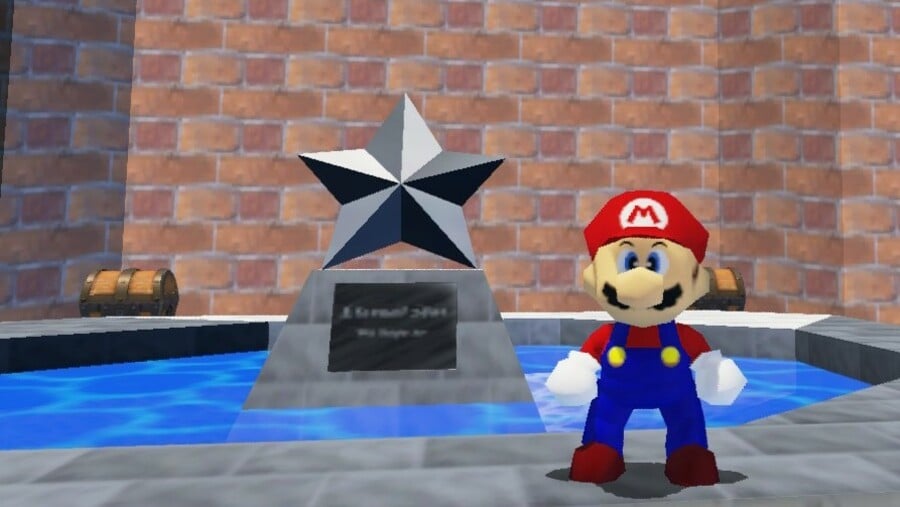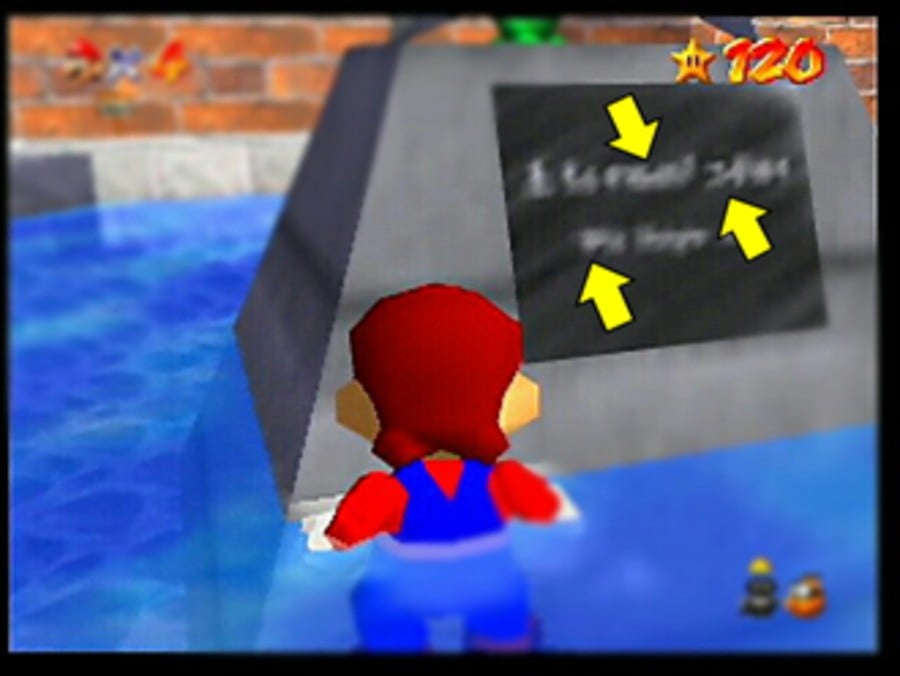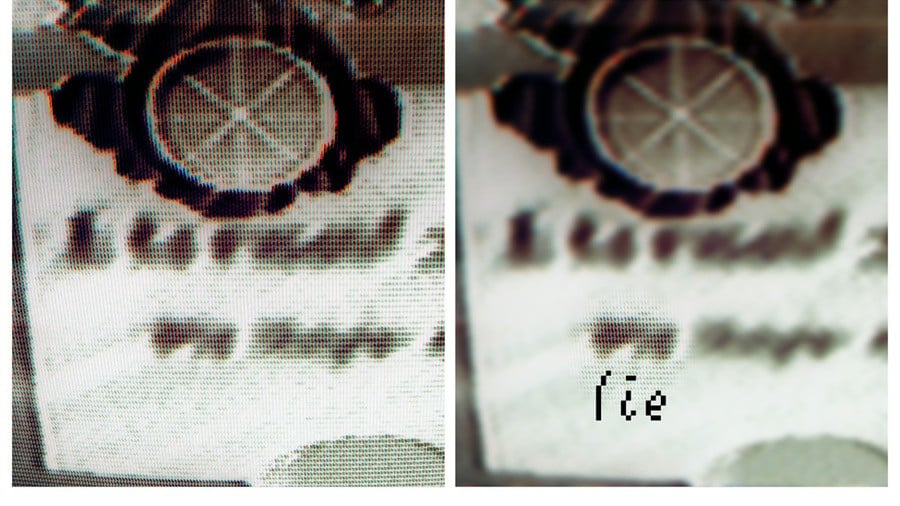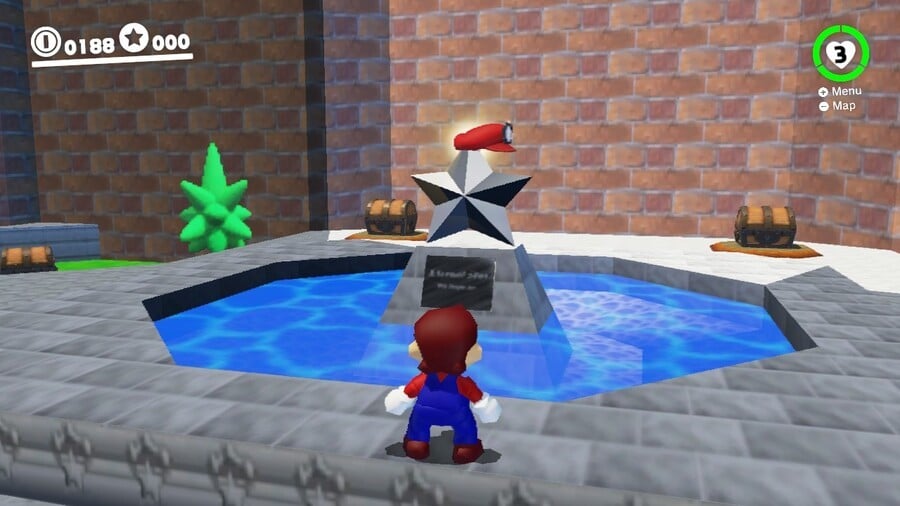
There's something about the very best video games which inspires obsession over the smallest details. Whether it involves (over)analysing a blurry texture, trying to decipher a muffled audio clip or simply experimenting in the world for the fun of it, some games lend themselves to being endlessly broken down and forensically examined. It's the kind of thing that keeps the Stop 'n' Swop legend from Banjo-Kazooie alive in the minds of fans long after the mundane reality of the abandoned feature was revealed. There's something delicious in the mystery of it all!
Super Mario 64 is one of those classics which still holds riches to discover even over two decades since release. Arguably its most tantalising mystery is the blurry text found in the Castle courtyard beneath a statue of a Power Star (pictured above). This statue, sometimes referred to as the 'Eternal Star', has been the subject of much speculation and heated debate over the years and still inspires curious minds to this day. Daniel Nodd, also known as No64DD, has been examining the evidence and believes he has found the truth behind the myth.

Legend (or was it an April Fool's Day joke?) has it that the blurry text on the plaque reads either 'Eternal Star' or 'L Is Real 2401', the latter apparently referring to Luigi being a playable character in the game. Despite multiple supposed methods to unlock the lankier Mario brother circulating back in the day, he was never found in the game even with N64.com offering $100 to anyone who could prove Luigi was playable (and remember, $100 in 1996 money could buy you a race horse or small semi-detached residence). The mystery was compounded when the plaque also appeared in Dodongo's Cavern in The Legend of Zelda: Ocarina of Time.
In the intervening years the question of the blurry text on the courtyard statue would bubble up every now and then, but a letter which appeared on reddit from a Nintendo Game Play Counselor in reply to a query back in 1998 arguably put a lid on the issue - it was simply a joke from the developers. The letter still didn't clear up exactly what the joke was, though...
Daniel wasn't satisfied that the mystery had been solved and set about his own analysis of the plaques in both Super Mario 64 and Ocarina of Time using a couple of N64s and some image techniques to enhance the text. Let's have a look at his work...
Note: Minor spoilers for Super Mario Odyssey follow, if you care about that sort of thing. You have been warned!
With the use of multiple television screens and smartphone cameras, I was able to capture, categorize, and display the best possible examples of the image(s).
To begin, I basically turned down all color and adjusted brightness and contrast on the CRT units, as well as turning up sharpness. The Nintendo 64s are running on AV and RF. Out of all the experimenting, taking photos in an inverted negative mode worked best.
These are unmodded N64 consoles. The device on the blue console is simply a universal adapter to play Japanese games.
The inscription uses the same in-game font from Super Mario 64. I applied it to each shot for better visual comparison. It reads:
A Secret star
lie here ~

I attempted to adjust the images even further through a few image apps you find on smartphones. Things like sharpness, shadows, white balance, etc. Finely tuning them worked to a point before affecting overall quality, but I also isolated and focused each section for a side-by-side comparison.

You can start to recognize the curvature, and how much anti-aliasing begins distorting the graphic.

This was taken in Ocarina of Time. Here, the inscription appears slightly bolder than SM64, but can clearly see the capital "S".

This area begins to become affected by the grain smear of the marble-like texture, but you can make out the silhouette of the lowercase "e".

Here, I wanted to point out the curvature of the lowercase "c", because this letter is also affected by smearing.

This normal Elgato screen grab illustrates a primary line of distortion running diagonally, and areas of text that are affected by this in the path.

Notice both lowercase "t"s in Secret star have the same slant at the bottom.

The "Eternal star" theorists did get this one correct. Lowercase star is clearly visible.

For the second line, the text gets smaller and more difficult to decipher. The lowercase "l" is heavily affected by the darkest streak on the memorial plaque, but the contours are still visible.

here is almost italic in appearance, but the angle of the lowercase "h" starts to become visible. This image also displays the lowercase "e" in lie much better.

And lastly, the final piece, which is actually a tilde. SM64 seems to have the best example. This was taken in black and white in 2015, back when I really started analyzing 'L is Real 2401'.
These tildes "~" are commonly used as memorial scribes on tombstones, which is what is represented in both games. The dead Dodongo that resides in its cavern in OoT, and a castle Secret star that metaphorically resides in the courtyard of SM64.
That was until Super Mario Odyssey.
Daniel's reference to Super Mario Odyssey is a secret star found by donning the Mario 64 cap and suit and transforming the portly plumber into his 64-bit self. This enables you to enter the courtyard in that game (in all its polygonal retro glory) and finally find the fabled 'secret star' by spinning Cappy on the statue, putting a cap on a 21-year mystery.

Or has it? In this day and age, why let facts and evidence get in the way of things - especially a good mystery - eh?!
Our thanks to Daniel for sharing his findings and the forum where his research started. What do you think? Case closed? Putting aside the lack of verb conjugation, this certainly seems more plausible than all surviving Super Mario 64 carts suddenly unlocking Luigi in the year 2401. Feel free to share your thoughts and own theories below.





Comments 74
Thankfully it is cleared up.
What an interesting brick joke. 21 years, huh?
Whelp, glad that's over and done with.
I like it. Right or wrong, this is very logical and plausible. It all fits for me.
I wonder if there was supposed to be a star inside that statue at some point in the development of the original N64 game (maybe for killing all the boos in the courtyard?), but they nixed it so then they made the plaque illegible on purpose?
honestly this was the most stupid puzzle people want to find out..
I mean, it's a Power Moon, but yeah, accurate!
Oh wait, Super Mario 64 DS...gah, these quantum parallel universes are confusing!
Just seeing an article about Super Mario 64 is awesome. Especially with the recent Sunshine tease.
I know it’s doubtful, but man, if they actually announced a Remastered Sunshine ☀️. 🙏
I’d want Super Mario 64 much more, but I’d be happy as ever with either. The N64 & GameCube are my biggest childhood nostalgia systems by far.
When i saw that place at 64 i knew it was call the secret star lives here.. sense i some how glitch to make it show normal..
I've always appreciated that mysterious aura Super Mario 64 had to it. I still get goosebumps when I remember the first time I saw the plesiosaurus in Hazy Maze Cave. Such a masterpiece.
Ok then what does this sign say? https://www.models-resource.com/resources/big_icons/2/1707.png
That's a lot of work when you could just extract the texture file from the game to work with directly.
This is awesome - I'll have to take a look at the sign with my ultrahdmi n64 tonight
EDIT: Looks like it says '_ __ real star'
EDIT 2: Can anyone with Odyssey check whether the texture looks any better in that game? I lent mine out to a friend who doesn't live close.
@CTmatic We did get a bunch of "Nintendo's thinking about Super Mario 64 HD" articles pre-Odyssey, but I suspect that the SMO Mushroom Kingdom homages were all that came of that.
Oh yes the old 2005 internet, I missed you
@link3710 I was wondering why they didn't do that too. Seems like the most accurate way to analyze the message would be to use the image from the file, not how it appears on a CRT television
I'm still going to wait until 2401 to see what nintendo announces
It’s about Mario 64. I had to click.
I can finally sleep after 23 years..... But is there hidden star??? There goes my sleep again .....
I spent a lot of time on the N64 and in the 3ds version of the game jumping and landing everywhere tro find something... Lol
Uhh... no... it says "L is real star". It's Engrish for Luigi is the real star. Since they removed him from Mario 64. A joke put in by the developers, just as it says in the official letter.
Not sure why there is still a debate here, "L is real 2041" or "eternal star" but no one thought to combine both theories? Come on guys, it's pretty obvious when you think about it
Edit: Here is my recreation https://images2.imgbox.com/c4/87/pbObRICJ_o.jpg
Not completely accurate as I used a different compression but you can see the spacing ends up exactly the same. Also there is no way the second word of the bottom line is "here", there is clearly a drop below the writing line so it could only be a p, q, y, g or j
Edit 2: And yes, the location means Luigi is dead, Luigi died for Super Mario 64 which is why he makes no appearance. It's all an inside joke though
@kingbowser86 But in this level you are actually collecting power moons that look like stars so.. damn thats weird
@Sashimi_64 Yeah... wasn't really a fan when they pulled that retcon in Odyssey. It would help in distinguishing the Power/Grand Stars from Invincibility Stars, but then you have the 3-Up Moon from SMW, so it's all fairly pointless.
A surprisingly wholesome and reasonable ending to this somewhat pointless pondering.
That cool, it's still don't make any sense
I want remastered Mario 64. Can it be that hard to do? Please Nintendo thank you xxxxx
"Lowercase star is clearly visible."
No! Not really.
Wow. Yeah, I noticed it was the same plaque as in Dodongo's Cavern and always read it as Eternal Star.
That's cool and all but that still doesn't explain why the same plaque was in Dodongo's Cavern...
@Shiro28 just a dev reusing assets
Perhaps that was the joke the developers spoke of; that there was in fact no star, and it was just a stone monument.
@CTmatic I'm with you on a Mario 64 remaster or remake. It remains one of my top 5 games, even with all its quirks and issues. I wouldn't even hesitate in buying it.
I'd be up for a Sunshine remaster as well. It wasn't my favorite Mario. But it was a good game. And honestly, I think Isle Delfino has to be one of favorite Mario game settings
@Aurumonado yeah, thought about it and couldn't be assed lol. Tho the next time I have it on I'll turn on the No AA APS on my Everdrive and combine it with the Ultra HDMI De blur. Should be alot easier to atleast work out then. Shocking how much the N64's horizontal blur alone actually smears over any detail.
I want my secret star damnit!
@link3710 hi.
Because it's only a 32×32 texture that is totally pixelated pre rendering.
Random uppercase, lowercase? Makes totally sense.🤨
@ummyeahnintendo I'll take this one. I have it nearly complete. Very dark texture.
"I am helping Mario
××××, ×××× press A or B
standing still".
@liveswired That texture is still going to be affected by anti-aliasing, but TVs are only getting better. 👍
A universal adapter to play Japanese games?
I just opened up my (spare) N64, pull out the plastic piece surrounding the cart slot and used some nail files to scrape away the edges of the plastic (on a US console. On a Japanese console I assume it would be the same as a US SNES and be easier to remove, likewise on a PAL N64 console except that PAL needs additional mods because of the CIC issue.)
@KingMike Hi.
It ended up in the photo switching between consoles, some that do have the inner tray removed, and to what tv i was using for which game, and between an everdrive. Lol
I just mentioned it in case someone wasn't sure.
When i said "unmodded, it was referring to HDMI/RGB etc.
Neat. My guess though, still, is that it's just gibberish meant to look like writing and the developers heard about the rumors and put this into Odyssey as an Easter Egg.
The whole endeavour seems wildly off the mark, even to the untrained eye. Because it's always seemed quite obvious, to me at least, that the texture in question is of Japanese text.
@Heavyarms55 No, but in Ocarina of Time, what is showcased as the native alphabet of Hylian is a mixture of gibberish and katakana.
What about that truck in the Vermillion City harbour, the grass next to Pallet Town, and whatever that thing that guy is building in Vermillion City?
@No64DD I can respect you put a lot of effort into this and such, major kudos to you for that, but I'm still skeptical. I can see where you get the letters you do, but it still looks like a stretch to me.
But that's fine, I'm just some random comment online. My skepticism is just that.
The amount of effort put into clarifying this is astounding. Thank you for the answer!
Honestly, I didn't need to do this to decipher "A secret star" when I played the game as a kid but the second line was always a mystery and illegible. "lie(s) here" makes sense since it's supposed to be a tomb.
The funny thing is that when I had 119 stars I was totally sure that the final star was here and spent hours doing all kind of things on the courtyard. I think that was the "joke" because I'm not the only one who did it.
@Shiro28 That was an Easter egg.
@liveswired @Scapetti
I'm looking at it with the horizontal filtering removed and I honestly think it's '_ __ real star'. The space between the 'se' and 'cret' in secret makes no sense - I don't see that at all. The bottom line is unintelligible.
Or it's all in japanese. The first character looks more like '上' to me than 'L' or 'A'
Awesome stuff like this is lost forever now sadly.
Nowadays with all the online patching and dlc and modding and so on.. it is a different era. Games are ever changing, not solidly set in stone like the unpatchable cartridges/CDs of old.
@gamekill we'll see.
@Aurumonado ... calm down. That's what it says tho.
@BlueOcean Great take on your experience with this game! Cheers
@rushiosan You're absolutely welcome. Legends never die, but they do get altered.
@Heavyarms55 and skepticism is what ends up completing it in the end, making it whole.
Did anyone else hear rumours that the glass-stained picture of Princess Peach on the castle was also an entrance to another world? I really hoped that was true until I collected all 120 stars and found out I couldn't. Would have been a really cool easter egg though.
Third person singular present conjugation is a real killer.
@Aurumonado I think the only reason the L might look like 上 is because of the shine present on the plaque. Take away those two little bits and you get an L. I am near 100% confident it is "L is real star". Especially as the next Mario game they decided to make was Luigi's Mansion
@Tetsuo_808 It looks nothing like katakana or hiragana and is far too basic to be kanji. It also has spaces between the words but Japanese is written without spaces. There are also no accents off the side of any of the letters, like が compared to か, or ぱ compared to は.
@gamekill You know you can uninstall patches, right? And old games were patched with new revisions of the cart, like the Islamic chanting removed from OoT. In fact, it's arguably better now because to get the v1.0 of OoT you'd need to track down a very specific cart but now you'd just not install any patches or remove any that were installed.
now that is mystery is "solved"; Nintendo needs to port Super Mario 64 over to the Nintendo switch. maybe it could include an HD remake with multiplayer action (adding Luigi as an unlock-able character) as well as the ability to stay in a level after collecting a power star.
@Matroska I disagree on all counts. It's perfectly common for character sets to be separated for visual purposes, as this plaque would be. The first symbol looks very much like kanji, possibly for じん. The third group looks certain to be katakana, with フ and イ highly possible. The bottom groups I'm less sure of. But I wouldn't be surprised if it's a mix of gibberish, Japanese, and English. I just find it very odd someone would spend so much time deciphering it when not a single character appears to be legible English in the first place. I guess only Nintendo knows, if the texture exists somewhere.
It's fun all this work to "finally" decipher this, and within minutes we're back to nobody even knowing what character set it is let alone what it really says.
My bet is "Sunshine 2020". Just a theory.
This has been really enjoyable joining nintendolife and getting to listen to the discussion here.
Yes, this is beginning to all make sense now.
On to the next mystery, why didn't Mario find evidence of the 1969 landing when he was on the Moon?
@No64DD Thank you!
@Matroska
Yes of course I am aware of all that. I think I did not get my point across. What I meant was more like.. at that whole offline starting era in game's history, games were much more of a closed thing (no Unity/Unreal, no data mining, no widespread and social internet). So it was almost as if the cartridges had definite, unchangeable, tangible content. In the player's imaginations. Kind of a difficult idea to explain really..
Japan is on board. 😍
https://automaton-media.com/articles/newsjp/20190829-100729/amp/
@No64DD Now everybody knows that the stone star is a tomb and sadly the star is no longer available.
So my main takeaway from this article is that there's a really easy Odyssey star that I didn't know about (I just got the one from the treasure chests), but after weighing up whether I can be bothered to go back and get it I've decided no.
SMO's moon/star collection end-game really spoiled the game for me - it's still an excellent game, but I can't remember the last Mario game I played where I didn't feel compelled to finish everything. I hope SMO2 delivers a stronger end-game.
Interesting story! And that Odyssey thing, I have to try that!
Update: I think I already got it.
well. now we know that he is and always was real
Now that we know that luigi is actually in Super Mario 64 your theory is still as good for you or not
@USR
I've been meaning to get to this. The evolution of it speaks to fan service in certain ways, but look how far it went!!
My evidence is sound, and I got to tell my side of it as well.
I really don't think you could've had one outcome without the other, that's what makes it so special.
People care about this stuff besides me. Their findings had nothing to do with the monument, but then it did in a way.
It's all part of the lore.
Tap here to load 74 comments
Leave A Comment
Hold on there, you need to login to post a comment...